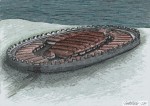 Archaeologists have found a Roman gold coin in a posthole from one of the homes in Sandby ringfort. The coin is a solidus from the reign of Western Roman Emperor Valentinian III in a design struck towards the latter part of his rule, 440-455 A.D. This is a find of great importance for Sandby, because it’s evidence that might help explain what happened there.
Archaeologists have found a Roman gold coin in a posthole from one of the homes in Sandby ringfort. The coin is a solidus from the reign of Western Roman Emperor Valentinian III in a design struck towards the latter part of his rule, 440-455 A.D. This is a find of great importance for Sandby, because it’s evidence that might help explain what happened there.
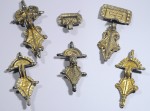 Sandby is a ringfort on Öland, an island off the southeastern coast of Sweden, that was built and destroyed during the turbulent Scandinavian Migration Period (400 – 550 A.D.). It was first discovered in 2010 when two looting pits appeared, alerting archaeologists to the pressing need to survey the area before depredations ruined the context. Come summer, the spot was surveyed with metal detectors and four caches of glass millefiori beads, small silver bells meant to be worn as part of a necklace of a bracelet, finger rings, gilt bronze and silver buckles of very high quality were found. Other artifacts were found scattered around the site.
Sandby is a ringfort on Öland, an island off the southeastern coast of Sweden, that was built and destroyed during the turbulent Scandinavian Migration Period (400 – 550 A.D.). It was first discovered in 2010 when two looting pits appeared, alerting archaeologists to the pressing need to survey the area before depredations ruined the context. Come summer, the spot was surveyed with metal detectors and four caches of glass millefiori beads, small silver bells meant to be worn as part of a necklace of a bracelet, finger rings, gilt bronze and silver buckles of very high quality were found. Other artifacts were found scattered around the site.
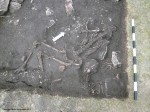 The next year excavations began. They revealed that an event of deathly violence had struck the fort in the 5th century. Its defensive high walls were overrun, the homes inside destroyed, its inhabitants killed and left to rot where they fell. Five bodies were found inside just one dwelling, all of them bearing marks of sharp force trauma. Only 2% of the site has been excavated, and the remains of about 10 people have already been found. So the residents were killed, their homes, warehouses and barns levelled, but the authors of this destruction left the expensive jewelry and gold behind. A raid for lucre wouldn’t have overlooked shallowly buried hoards and wouldn’t have killed everyone before they could reveal their hiding places.
The next year excavations began. They revealed that an event of deathly violence had struck the fort in the 5th century. Its defensive high walls were overrun, the homes inside destroyed, its inhabitants killed and left to rot where they fell. Five bodies were found inside just one dwelling, all of them bearing marks of sharp force trauma. Only 2% of the site has been excavated, and the remains of about 10 people have already been found. So the residents were killed, their homes, warehouses and barns levelled, but the authors of this destruction left the expensive jewelry and gold behind. A raid for lucre wouldn’t have overlooked shallowly buried hoards and wouldn’t have killed everyone before they could reveal their hiding places.
Leaving the bodies in the open to decay was a deliberate choice, perhaps a warning to others, and it was an effective one since nobody occupied the fort again. That’s what makes this find so exceptional: a moment of destruction has been frozen in time for archaeologists to study like forensic units study a crime scene.
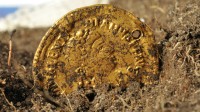 The solidus may be a key witness. About 360 solidi have been found on Öland, but they were stumbled upon, mainly during the plowing of fields, not excavated. This is the first solidus to have been unearthed in its original archaeological context: one of the homes where human remains were discovered. These coins were used by the Roman Empire to pay its mercenaries. One of the theories about what happened at Sandby is that it was home to returning soldiers rather than farmers grouped together for self-defense like the other ringforts on the island. Seen as a threat by their neighbors, they were raided, killed and left as a cautionary tale to any other mercenaries who might consider banding together and using their military skills to interfere with the pre-existing communities.
The solidus may be a key witness. About 360 solidi have been found on Öland, but they were stumbled upon, mainly during the plowing of fields, not excavated. This is the first solidus to have been unearthed in its original archaeological context: one of the homes where human remains were discovered. These coins were used by the Roman Empire to pay its mercenaries. One of the theories about what happened at Sandby is that it was home to returning soldiers rather than farmers grouped together for self-defense like the other ringforts on the island. Seen as a threat by their neighbors, they were raided, killed and left as a cautionary tale to any other mercenaries who might consider banding together and using their military skills to interfere with the pre-existing communities.
Another theory is that it was the violent resolution of a feud.
“We think it may have been the reason for the massacre at the Sandby Borg fort. And this is the only coin that wasn’t taken,” [lead archaeologist Helena Victor] explained.
“We found it on the edge of a posthole in the house. So maybe the robbers came to take the treasure there, and maybe they ripped the bag and one coin fell down into the posthole in the floor, and there it remained.” […]
“I think that the money was a good excuse to end a feud. So there was probably a feud, this was a very strong statement, not just a normal robbery- an excruciatingly evil statement to kill these people and just leave them,” Victor explained.
“It was truly shameful. So to make a real statement you forbid them to burn the bodies. There are still memories 1,500 years later of these events, it’s a dangerous place. Parents tell their children that they can’t play there because it’s a dangerous place. They don’t remember the history but they remember it’s dangerous.”
 It looks to me like the coin was pierced which suggests that it was worn as jewelry at some point. Instead of being in bag, it could have been on a string around someone’s neck and fell into the posthole when it was unceremoniously separated from that neck by force.
It looks to me like the coin was pierced which suggests that it was worn as jewelry at some point. Instead of being in bag, it could have been on a string around someone’s neck and fell into the posthole when it was unceremoniously separated from that neck by force.
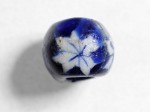 After conservation and further study, the coin will go on display in the Glimpses from Sandby borg exhibition at the Kalmar County Museum in southeast Sweden. The mini-exhibition opened last month after visitors clamored for news about the fort and its treasures. Mostly the exhibition uses images and text to tell the story, presenting some of the theories about the fate of Sandby, but there are a few artifacts on display — 30 glass beads, an iron spearhead almost two feet long. The coin will be joining them this fall.
After conservation and further study, the coin will go on display in the Glimpses from Sandby borg exhibition at the Kalmar County Museum in southeast Sweden. The mini-exhibition opened last month after visitors clamored for news about the fort and its treasures. Mostly the exhibition uses images and text to tell the story, presenting some of the theories about the fate of Sandby, but there are a few artifacts on display — 30 glass beads, an iron spearhead almost two feet long. The coin will be joining them this fall.